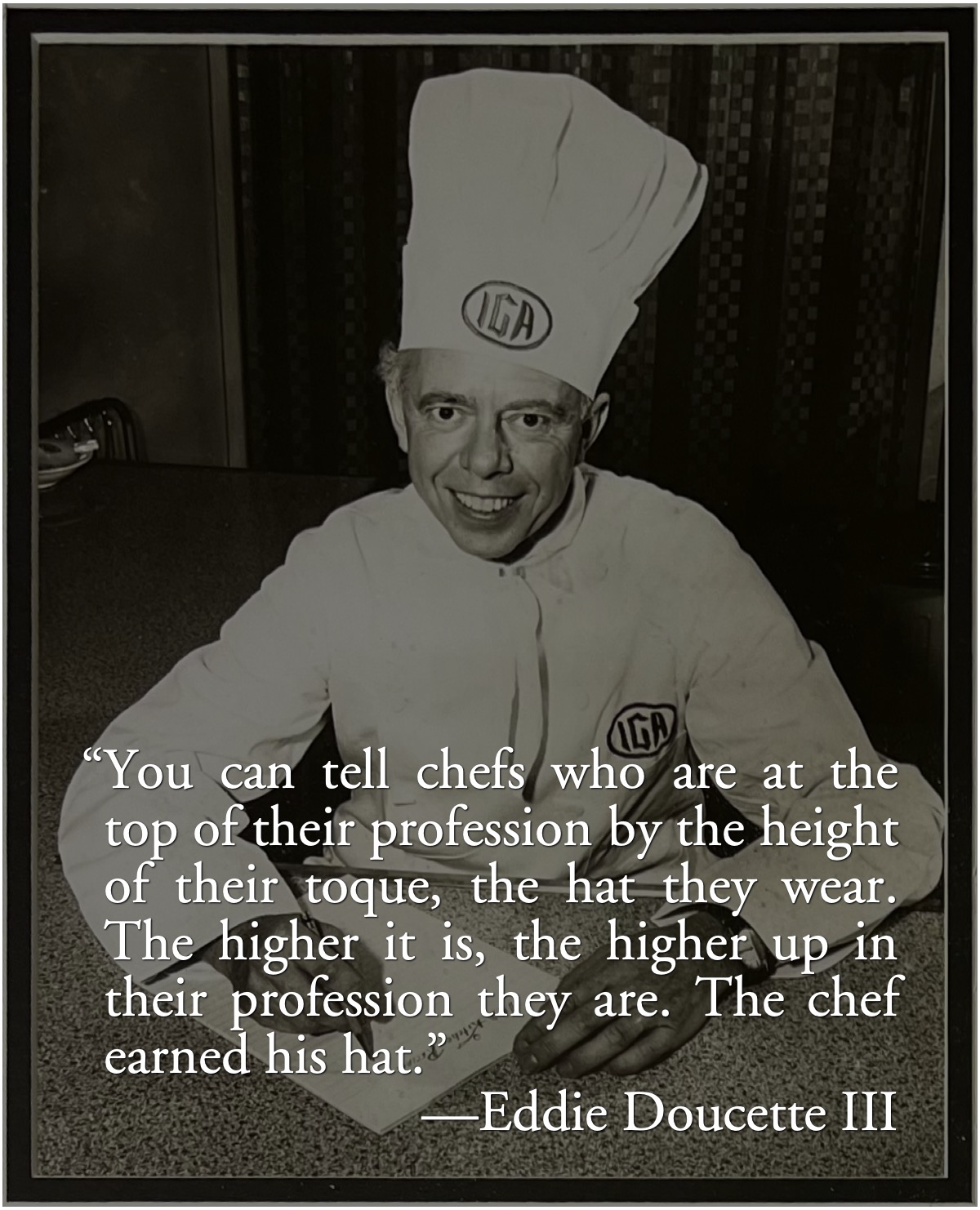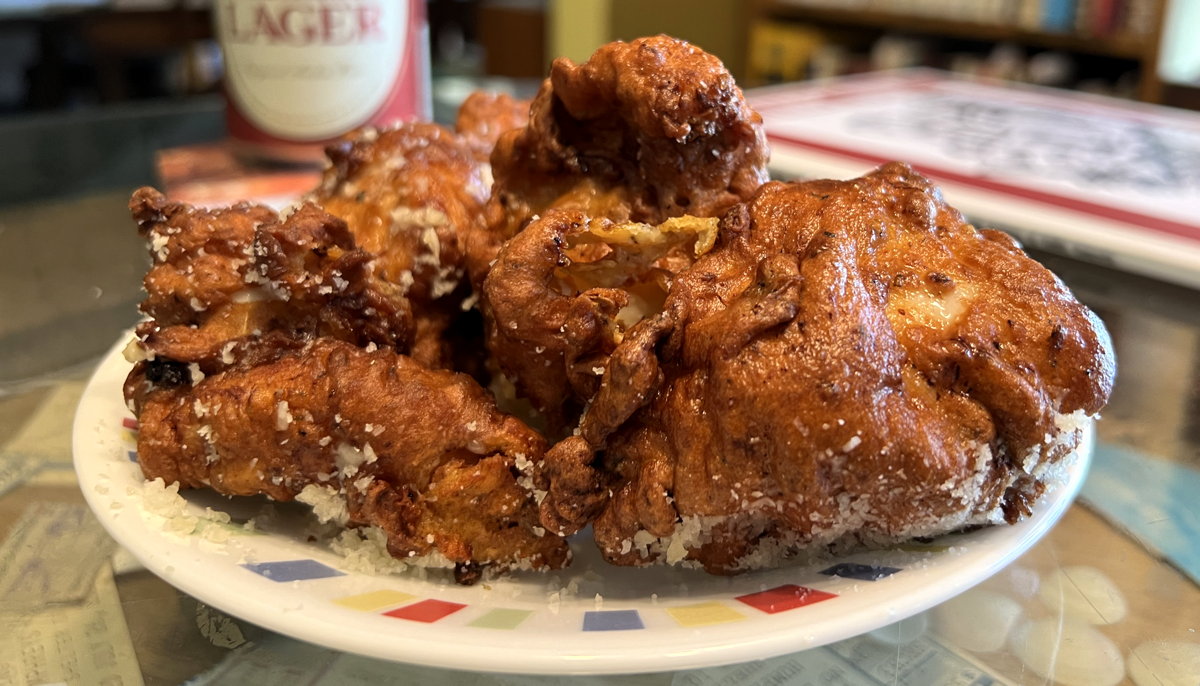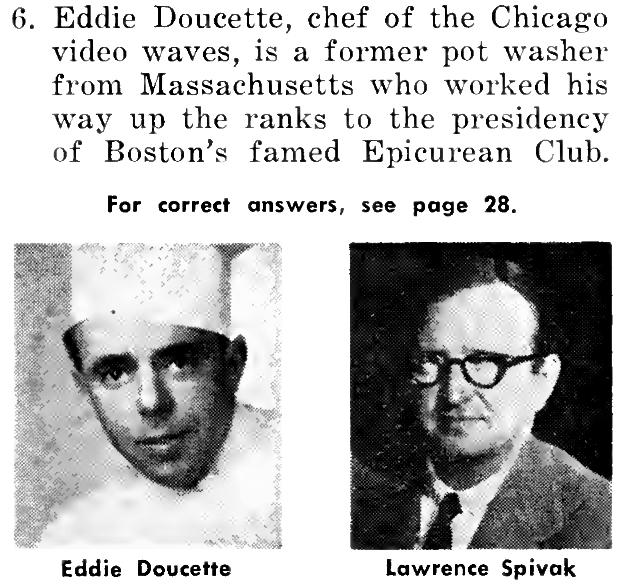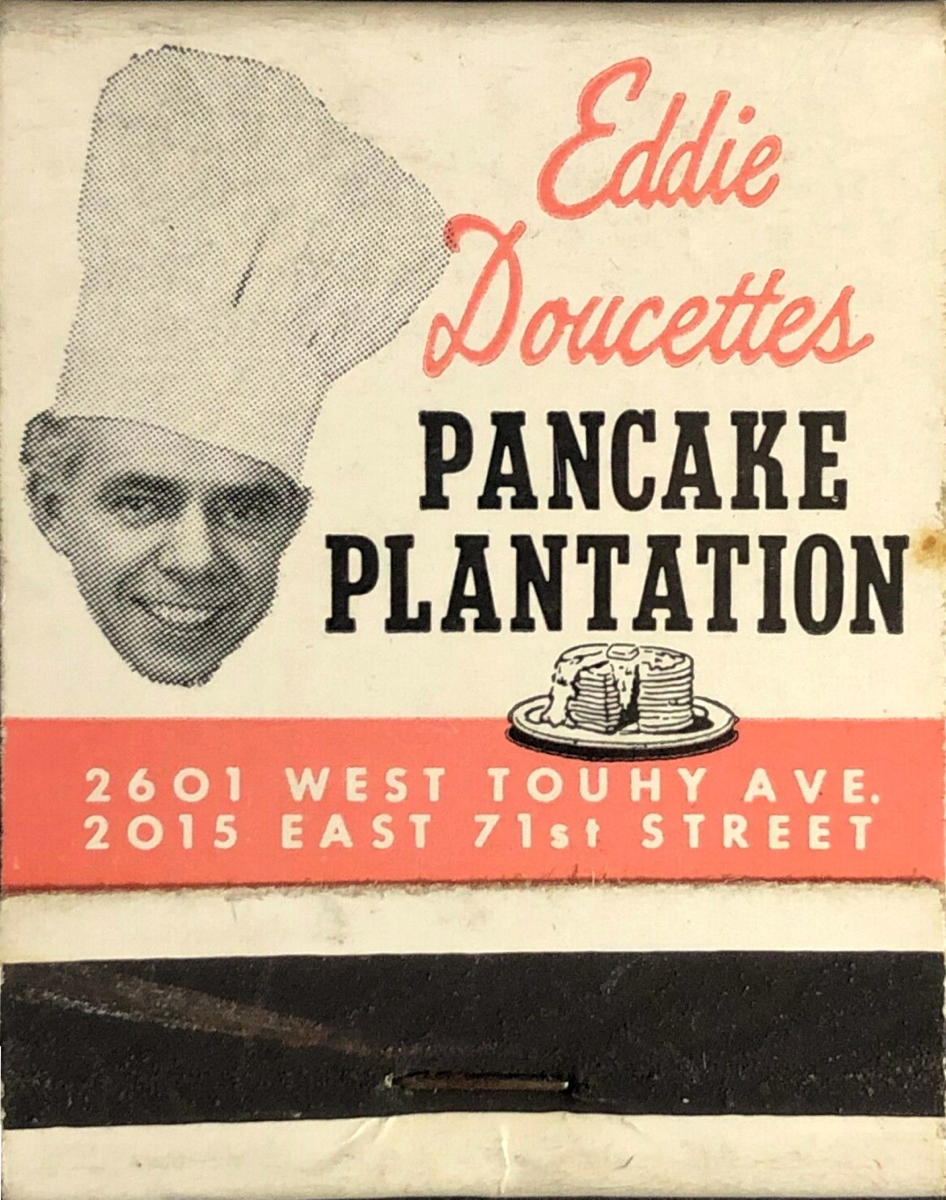“He Was the Chef”: Remembering Eddie Doucette, Jr.

“I remembered something my dad told me,” Doucette said. “He had a cooking show on NBC television for years… he knew the business. He said to me, ‘Be yourself, and nobody else. Don’t be an imitator; be a creator.’ Those words always stuck with me.”—Eddie Doucette III
In February I chatted for a few hours with sportscaster Eddie Doucette about his father the chef, whose recipes I’ve collected in Tempt Them with Tastier Foods.
“I think most people don’t remember Eddie Doucette the cook,” his son said toward the end of our talk.
Most people if they remember anything with the name Doucette it would be because of my more recent time in the media. It’s a shame, that someone like him who was truly a legend in his profession, that there’s not much notoriety for him today.
That certainly seems to be the case. The 1985 Chicago Celebrity Cookbook by Ann Gerber doesn’t include any mention of Eddie Doucette. Nor does Mike Douglas’s 1969 The Mike Douglas Cookbook, even though by then Eddie had made several appearances on the show.
When I first ran across the name, it was atop a few pages of recipes a viewer had typed up from his Chicago-area television show, Eddie Doucette’s Home Cooking.
He had savoir faire, that ability to make you want to sit up and move closer to the TV, grab a paper and pencil and start writing it down.
Despite the title of the show being typed across the top of the documents, the eBay seller I bought them from thought it was from an old defunct restaurant—probably because that’s the only food-related hit that came up in an Internet search on Eddie’s name.
New England
The earliest reference to Chef Eddie Doucette that I can find is the 1940 census for Felchville-Natick (JPEG Image, 1.0 MB), Massachusetts. His occupation is listed as “Chef” at a “private school”. He has a wife Teresa, and a son Edward. The Doucettes are 26, 24, and 2 years old, respectively. He’s working year-round (52 weeks a year) and full-time (48 hours a week). He makes $2,080 annually. They’re living on 7 Atherton Street in Natick.
All three of the men referred to in this interview are named Eddie Doucette. Eddie Doucette the chef was Eddie Doucette, Jr. The chef’s father was Eddie Doucette Sr. and his son, the sportscaster, is Eddie Doucette III. Wherever I refer to “Eddie” or “Eddie Doucette” I am referring to the chef. All of the quotes in this piece, unless otherwise credited, are from Eddie Doucette III, the sportscaster and son. If it’s not a quote, it’s my paraphrase of the interview or my own research, which I’ve linked to wherever possible.
Eddie Doucette III is very proud of his father’s skills not just as “the chef” but as an artist and a father. Much of what we talked about was less about cooking than about family. Eddie Doucette was born in the early nineteen-teens, 1911 according to his son and around 1913-1914 according to the census.1 He grew up in and around Newtonville, Massachusetts. His father, Eddie Doucette Sr., was a carpenter. At one point when the family needed another source of income Eddie’s mother Judith opened a breakfast place in Newtonville called “Ma Doucette’s Kitchen”.2
Eddie left high school to support his family—he was the oldest of twelve—when he was a sophomore. That meant, among other things, helping at his mother’s restaurant. Ma Doucette’s Kitchen3 was a breakfast place. “People came in to get coffee and sweet rolls.”
This would have been around 1927-1929, just before the Great Depression. As Eddie learned that he enjoyed professional cooking, he began a long career of learning. He worked summers at nearby women’s colleges in Massachusetts and Vermont for the summer tourist trade. He became assistant to the head chef at Vermont’s famous Bread Loaf Inn, and may have become the head chef there by 1940, depending on how Peter Stanlis’s recollection, below, can be interpreted.
His experiences at the inn may explain his life-long interest in poetry. “Every year he’d write an ode to my mother on their anniversary, birthdays, Christmases,” said his son, “and when he got on TV became known as the poet with a skillet, or something like that.”
According to food historian Dana Polan, one of Eddie’s trademarks is that he “recited original poetry while demonstrating cooking techniques”.
“The man had a gift,” said his son. “He had a philosophy that he built into everything.” He once asked Eddie about the poetry, some of which “was just very profound.”
“Where did you get all this wisdom?” I asked.
He said, “During the summer when I was at the Bread Loaf Inn, after the lunch hour I would take a break before the dinner would start. I’d go out and there was a gentleman I’d met who used to sit on the hill. And we used to talk, we’d just talk about life, about his career, and the things he did and his perspective on living and life and the way things should be.
“This was a man that had been around the world, and left his thoughts about everything that he had ever seen in the form of poetry.”
I said, “No kidding! Who was this guy?” It turned out to be Robert Frost.
Eddie Doucette did in fact encounter Robert Frost at the Bread Loaf Inn, and Robert Frost did in fact interact with the restaurant’s staff. According to Peter J. Stanlis in Conversations with Robert Frost:
A week after Frost’s poetry reading Harry Owen told me he had arranged with Frost for the two of them to have a private lunch with me at Bread Loaf, to celebrate my having received the Elinor Frost Fellowship. On Wednesday, July 10, I was relieved of waiting table for that day, the chef at Bread Loaf, Eddie Doucette, baked a cake for the occasion, and Frost, Owen and I enjoyed lunch together in the dining room…
That was July 10, 1940. Stanlis was a student at the Bread Loaf Graduate School of English at the time, and, judging from his account, part of the waitstaff at the Bread Loaf Inn.
By 1940 Eddie was already married. He’d taught himself to play piano in his early twenties. While playing at a local musical show, Eddie’s son told me, Eddie met “one of the girls in the show who turned out to be my mother.”
Teresa was born in 1915. She was second-generation Italian; Eddie had to go through a virtual “barbed wire fence” to see her: she had an older brother who was a boxer, and very protective of his sister!
They had two children. Their oldest child grew up to be a sportscaster. That’s Eddie Doucette III, the legendary “Voice of the Milwaukee Bucks”, who I interviewed for this piece.
What were the son’s favorite foods growing up? “Dad’s Italian recipes were out of this world. I loved his Italian. His desserts were otherworldly.”

Eddie Doucette’s Fried Chicken Italienne
Servings: 4
Preparation Time: 30 minutes
Eddie Doucette
Tempt Them with Tastier Foods: An Eddie Doucette Recipe Collection
Ingredients
- 2 eggs
- ½ cup milk
- ¾ cup flour
- 1 tsp salt
- 3 tbsp tomato paste
- 1 tbsp grated Parmesan
- 1 tsp oregano
- ½ tsp pepper
- 2 lbs small serving-sized chicken pieces
- lard or shortening to fry
Steps
- Make a batter from the eggs, milk, flour, and salt.
- Blend in the tomato paste, Parmesan cheese, oregano, and pepper.
- Dip chicken pieces into the batter to coat.
- Fry in 325° fat until golden brown and tender, about eight to ten minutes, depending on size of pieces.
- Sprinkle with more Parmesan cheese.
Over the years Eddie would combine cooking with painting and sculpture as well as poetry. As the head chef at the Andover Inn—he’d moved the family to Massachusetts after 1940—he provided the ice sculptures for the Andover Inn’s Sunday buffets.
Everything he ever did was creative with food as a background.
The food industry at that time was an art form. If you went out to eat you went to a restaurant and a chef put on a performance. That was his thing. My dad took a liking to it because he had a natural feeling for the arts. He created in food colorings and chocolates, and portraits for several celebrities all over the country, including President Roosevelt, and a painting of Iwo Jima.
He also used to do portraits of my mother, who he revered.
A 1964 article in the Idaho State Journal notes that:
He is a specialist in making “Portraits in Chocolate” and has created chocolate pictures of such personalities as MacArthur, Chang Kai Shek and Mrs. Eleanor Roosevelt.—Idaho State Journal, June 9, 1964
Around 1943 Eddie was drafted into the Navy for World War II. This not only put a hold on his career as a chef, it also changed his family’s life. Teresa had to go back to work. The family moved into Waltham, with her parents. Eddie’s son remembers living with an extended Italian family as a “terrific upbringing”.
I grew up Italian basically. My mother used to talk to me in Italian when she didn’t want my dad to hear what she was saying.
Eddie Doucette continued improving as a chef.
When he wasn’t in the service he was away a lot because the work would take him away for periods of three months for the summer season. He would always be working with well-known chefs in the East to learn his trade and develop a name.
After moving his career and his family to Boston, he joined the Culinary Arts Society of America as well as Les Amis d’Escoffier, among other local and national professional organizations.4 In 1947, while he was president of the Epicurean Club of Boston and working at the Andover Inn, the Epicurean Club sponsored a multi-city event “to educate the American public to the qualities of fish in the interest of conserving grain”.
Five chefs from well-known Boston hotels and clubs took off by plane for five major inland cities today to prepare fish dinners at club luncheons so that more grain can be shipped to Europe.—The Benton Harbor Herald-Palladium, November 3, 1947
Eddie flew to Detroit to prepare a luncheon of “baked fillet of haddock” for his lucky (and unnamed) diners. Ironically, a different chef went to Chicago, which was soon to become Eddie Doucette country.
Chicago

During his time in Boston the International Mineral & Chemical Company saw some of his teaching presentations. They asked him to demonstrate their MSG product, Ac’cent, around the country. In 1949, for example, he attended the Wisconsin Restaurant Association’s 16th annual Food and Equipment Exposition in Milwaukee.
Nationally famous chefs, including Edward Doucette of the Amino products division, International Minerals and Chemical Corp., Chicago, will assist in a special demonstration on buffet suppers.—The La Cross Tribune, March 24, 1949
NBC saw his Ac’cent demonstrations and asked him to do a cooking show in Chicago. When the 1954 Home Cooking with Eddie Doucette morphed into a 1955 variety show he remained in the title of Bob & Kay With Eddie Doucette. His recipes continued to be featured in the very small TV Guide blurbs.
I grew up reading the TV Guide and still have a couple of issues. For most episodes listed in the Guide, there was a listing with a name and a time. It was only the big things, the real draws, that got mentioned in the description. Eddie Doucette didn’t just get name-checked in the blurb, even the recipes he was making that day often got space. And when Home Cooking morphed into the variety show with Bob Murphy and Kay Westfall, they still highlighted Eddie Doucette and his recipes.

He was even the subject of trivia questions, as in this 1952 issue of Chicago’s TV Forecast (PNG, 707.5 KB).
According to his son, his cooking was popular with the television crews.
I would go in there and after the show these people on the crew, the cameramen, the studio people, the producers, the line producers, the assistant directors, they would fight to get in line to where the food was. There was never anything left, believe me.
When Eddie started presenting food on television he didn’t just use his test kitchen—set up in the basement of their house in Evanston, Illinois—to test the food he’d be preparing the next day. He experimented with the language he’d use to present the food. “Every night he’d take a little time off and… read English books” to hone his ability to speak, to develop his grammatical and inflectional skills.
Home Cooking may not have been his first television show. According to Dana Polan, at some point he also did a show called Creative Cooking.
Eddie Doucette, who hosted Creative Cooking at WNBQ in Chicago, recited original poetry while demonstrating cooking techniques.—Dana Polan, Julia Child’s The French Chef, p. 66
I can find no evidence of a show by that name on WNBQ, but there was a Creative Cookery that ran from at least 1951 through 1959 on WNBQ, and may have continued later on other stations. I can find no evidence (other than Polan) connecting Creative Cookery to Eddie Doucette; it appears to have featured a Chef Francois Pope and family.
It’s very possible that Polan was conflating two different, competing cooking shows from the same time period. That would also explain the hybrid name “Creative Cooking”, combining “Creative Cookery” with Eddie’s actual show, “Home Cooking”.5
If “Home Cooking” wasn’t his first cooking show, it definitely wasn’t his last. He had another show in the 1967-68 season that aired in Ohio and Michigan. It was called “Cooking Can Be Fun” and was advertised in local IGA ads.
The chef’s first job was in his mother’s breakfast diner, and he continued to love breakfast throughout his life. One of the things that Chicagoans still remember about Eddie Doucette was a restaurant called Eddie Doucette’s Pancake Plantation.
While he was at NBC he always used to take the family out for breakfast. He liked breakfast. He came up with his idea for the pancake house. The original Pancake Plantation was the first of its kind, maybe in the entire country; if not, certainly in the Chicago area. When I’d come home from college I’d help him out in the summertime a little bit, being a maitre’d of sorts, or cleaning tables, whatever I had to do.
He created his own syrups for the restaurant, and you could buy bottles of them on the way out.
But he got involved with a couple of partners that were playboys. They kind of blew that whole thing up. I told him one day, “hey, you got to get out of this thing because these guys are no good.” He did.
After he left the restaurant business, he started working for the Independent Grocers Association. IGA stores were predominant in the midwest, but spread throughout the United States and even into Canada. Most of Eddie Doucette’s recipes in Tempt Them with Tastier Foods come from his IGA period because these recipes were printed in newspaper ads throughout North America. He traveled the country to promote IGA products on his own and as part of larger events. He’d do his presentations everywhere: high schools, theaters, wherever he could reasonably do a cooking demonstration. It was very similar to what he’d done for Ac’cent.
He also appeared on other people’s television shows to demonstrate home cooking techniques. He was a guest at least five times on the Mike Douglas show between 1963 and 1966, and also appeared on the Merv Griffin show at least once, on May 25, 1965.
On the request of the USDA he “demonstrated foods from the United States” in 1965 at the Blackpool, England, Northern Hotel and Catering Show (Foreign Agriculture, Volume 3), and in 1968 at the International Trade Fair in Tokyo (The Macaroni Journal, March, 1969).
No matter what kind of food or technique he demonstrated, he always emphasized that cooking in the home was fun. It was literally the title of many of his traveling shows and his appearances. I’ve reprinted some of them in Tempt Them with Tastier Foods: “Cooking can be fun.” “You can have fun with yeast.” “French cooking can be fun.” “Electric cooking can be fun.”
You could always look at a picture of him and see a guy that really was enjoying what he was doing because he had a great smile. I have three or four pictures here in my office of him. He always had a personal note on them. He was always very proud of his two boys.
He was appointed by the White House to be a culinary ambassador for the United States. Eddie was well-known enough that by the late sixties, said his son, he picked the chef for Lyndon Johnson’s White House. “Because he knew all these guys, and he knew what they could do.”
The chefs at that level used to get together once or twice a year. When we moved out to Chicago, they would get together at the Palmer House. One chef’s job was to put on a performance for all the other chefs in the area.
This is how they grew their fellowship and were able to exchange secrets, and really became polished in what they did. It was an incredible universe that they had.
A lot of the research I do for vintage recipes brings up columnists sharing recipes that come from some cookbook, or that feature some company’s ingredient. It’s usually very matter-of-fact. You can see it in Byrd Weyler Kellogg’s recipe for corn meal hermits pulled from Ellen and Vrest Orton’s Cooking with Wholegrains. Or in Joyce Macey’s recommendation of El Molino Mills as a source for carob for her banana splits. I noticed very quickly that whenever someone mentioned Eddie Doucette in a newspaper article, it was never matter-of-fact. They were always very proud to have been his friend and they were always very proud to pass on one of his recipes.
“If you’d like to make your own barbecue sauce for this dish,” wrote Charles Flynn in his Mostly for Men column of June 24, 1971 in Chicago’s Daily Herald, “try this unusual combination which was developed by my good friend, Eddie Doucette, and has a delightful lemon flavor.”
He then reproduced Eddie Doucette’s lemon barbecue sauce verbatim from Eddie’s IGA advertisements!
“He was dedicated to what he did,” said his son, and when they went out to eat, “my dad would always ask to see the chef… he would always make sure to go in the kitchen.”
My dad would always take home one of the menus for his own library. For the people that he felt were doing the best job in these restaurants, he would send people there. But he would always make sure to go in the kitchen because you can tell about the chef by how orderly it was, how clean it was, how things were moving.
Later on my dad would try and help young kids who really wanted to become chefs. How to do the thing right. He got them sent to certain cooking schools and areas of the country. He would work with these kids and try and get them headed in the right direction.
Eddie and Teresa retired to Ft. Pierce, Florida, but he continued to enjoy cooking, and he continued to help new chefs. A friend who met him in Florida in 1983, Chef Rick Streeter, wrote that “His chef coat was embroidered on the back with Over Seventy and Still Cooking!” Rick added that Eddie was “instrumental in my decision to become a chef.”
He was a friend and mentor… always cheerful and entertaining. Above all, Eddie was a wonderful human being, and his memory should not be lost to time.
Teresa died in 1984, “and that took a heavy toll on him,” Rick wrote. But Rick still “had dinner with him on occasion [and he] always was there for advice.”
Eddie Doucette died in 1995. “I was very blessed,” said his son, “to have had a father and mother like I had.”
He always said, “when you leave the world you want to leave with love and respect.” He did it to the fullest. He was a man that earned every step he took. The chef earned his hat. He was the chef.
In response to A home-cooking handful from Eddie Doucette: A glimpse at a long-lost 1954 Chicagoland television cooking show, including recipes. They were typed by a viewer, so some of them require creative interpretation.
I’m inclined to believe the son is closer to the truth than the census. For various reasons, inconsistent ages in census records is a known problem.
↑I can find nothing on the net about this, but that’s not surprising. Not only would it have been a small restaurant unlikely to be remembered at this late a date, unlike, say, Eddie Doucette’s Pancake Plantation, it’s also likely that “Ma Doucette” was a play on a French phrase that is also used for song titles.
↑”I never got the name of the place. My dad mentioned it more than once and I think it was Ma Doucette’s Kitchen.”
↑Over his career, he also served as president and as vice president of the Chefs’ of Cuisine Association of Chicago, chairman of Les Amis d’Escoffier of Chicago, secretary for the International Cooks Association of Chicago, executive secretary of Les Amis d’Escoffier of Boston, and Good Will Ambassador and Vice-President of the American Culinary Federation, probably among many others.
↑This theory is undercut by Eddie’s son also mentioning an NBC show called Creative Cooking in at least one interview. That said, the interview was 2013, fifty to sixty years after any such show would have aired.
↑
books
- A home-cooking handful from Eddie Doucette
- A glimpse at a long-lost 1954 Chicagoland television cooking show, including recipes. They were typed by a viewer, so some of them require creative interpretation.
- Tempt Them with Tastier Foods: An Eddie Doucette Recipe Collection
- When I get locked into a serious recipe collection, the tendency is to take it as far as I can. You can benefit from my obsession with this collection of wonderful recipes from the fifties and sixties “files of Eddie Doucette”, television personality and IGA chef.
Eddie Doucette
- Eddie Doucette, the Voice of the Milwaukee Bucks at Wisconsin Museum of Broadcasting
- “The original Voice of the Milwaukee Bucks was known for his innovative radio play-by-play style that incorporated such a unique variety of original phrases that he published a dictionary of his phrases… He began his career as a disk jockey at WKRC radio in Cincinnati in 1961 and… began his full time sports broadcasting career in 1969 with the expansion NBA team, the Milwaukee Bucks and served as their radio and TV play-by-play announcer for 16 years.”
- Macaroni Menu Magic
- Eddie Doucette, Consultant Chef, shows you “How to Prepare and Serve Spaghetti Macaroni Noodles”. “Happiness is macaroni.”
- Remembering Eddie Doucette's Pancake Plantation Restaurants in Chicago: Dr. Neil Gale at Digital Research Library of Illinois History
- “Eddie Doucette's Pancake Plantation had two locations in Chicago around the 1950s and '60s. The first one was on Chicago's Far North Side at 2601 West Touhy Avenue on the southwest corner of Rockwell.”
- ‘The Master Of Nicknames’, Eddie Doucette Takes Home The Curt Gowdy Award: Casey Holdahl
- “On September 7, 2013, former Trail Blazers radio and television play-by-play man Eddie Doucette will be awarded the Curt Gowdy Award in Electronic Media, the highest honor bestowed upon an NBA broadcaster, as part of the 2013 Naismith Memorial Basketball Hall of Fame induction ceremony in Springfield, MA.”
miscellaneous
- El Molino Best: Whole grains in 1953
- El Molino Mills of Alhambra, California, published a fascinating whole grain cookbook in 1953.
- Review: Cooking with Wholegrains: Jerry Stratton at Jerry@Goodreads
- From salt-rising bread to Green Mountain hermits to cornmeal beef casserole, and a beautiful book to boot.
research
- Census Birth Year Errors: Rhonda R. McClure
- “How common are errors on birth year and age that is found on Census records?”
- Do you know the stars? (PNG, 707.5 KB)
- Six trivia questions about the stars, page 17 of the April 26, 1952, TV Forecast for Chicago.
- Natick, Massachusetts 1940 census (JPEG Image, 1.0 MB)
- A page from the Felchville-Natick 1940 census, including Chef Eddie Doucette and his family.
More Eddie Doucette
- Tempt Them with Tastier Foods: Second Printing
- The second printing of Tempt Them with Tastier Foods contains several newly-discovered Eddie Doucette recipes, as well as an interview with the chef’s son, Eddie Doucette III.
- Eddie Doucette’s Potato Bread
- This is an amazing bread for breakfast or sandwiches, easily made in a bread machine. It’s a great choice for National Sandwich Day this Friday.
- Oktoberfest Sauerkraut for Potato Day
- This simple sauerkraut casserole turns into an amazing National Potato Day treat when topped with mashed potato.
- Eddie Doucette recipe sampler
- Despite their occasional weirdness, I’ve yet to try a recipe that didn’t turn out at least pretty good. Some are amazing.
- Tempt Them with Tastier Foods: An Eddie Doucette Recipe Collection
- When I get locked into a serious recipe collection, the tendency is to take it as far as I can. You can benefit from my obsession with this collection of wonderful recipes from the fifties and sixties “files of Eddie Doucette”, television personality and IGA chef.
- Two more pages with the topic Eddie Doucette, and other related pages



